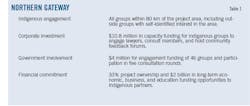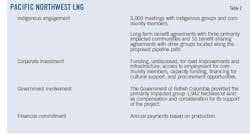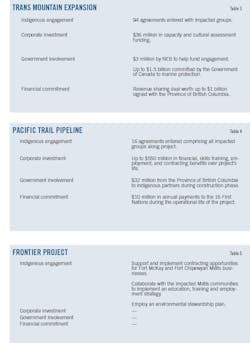Early engagement of indigenous peoples reduces project risk
Thomas Isaac
Cassels Brock & Blackwell LLP
Vancouver
Stuart Blyth
Cassels Brock & Blackwell LLP
Calgary
Arend Hoekstra
Cassels Brock & Blackwell LLP
Vancouver
By developing an effective engagement strategy that considers the specific rights of potentially impacted indigenous peoples at the outset, oil and gas proponents in Canada can reduce the risk of costly delays, find project partners, and win community support that will advance project development. Indigenous rights play a significant role in oil and gas exploration, development, and transportation in Canada. The constitutional protection of these rights impacts how governments and regulators review and approve resource and infrastructure development. For potential investors seeking government or regulatory approvals, understanding indigenous rights in Canada can help reduce the risk of costly delays, negative public perception, and even physical obstruction.
The last few years have marked a difficult period for Canadian oil and gas projects. While oil production has grown in Canada, access to markets has shown little improvement, with pipeline projects facing increased political, economic, and regulatory obstacles. Much of the public opposition to oil and gas projects is focused on carbon emissions. Legal challenges to these projects, however, have been rooted in both environmental law and in a principle first enshrined in the 1982 Constitution of Canada: aboriginal and treaty rights, Canada's form of indigenous rights.
Aboriginal, treaty rights
Canada's indigenous peoples are made up of First Nations (indigenous communities south of the Arctic, which pre-date European settlement), Métis (mixed ancestry peoples descending in part from early European arrivals and maintaining a distinct culture), and Inuit (northern coastal peoples predominantly residing in the Arctic and Subarctic). Together, these distinct groups of peoples are identified in Canada's constitution as "Aboriginal peoples" who possess two forms of indigenous rights in Canada: aboriginal rights and, in some cases, treaty rights.
Aboriginal rights acknowledge that indigenous peoples were living in communities with distinct cultures prior to European contact. Aboriginal rights protect the practices, customs, and traditions integral to the distinctive culture of these indigenous groups. These rights can include, among other things, the right to hunt, trap, fish, log, or sell resources commercially. Treaty rights, derived from agreements that Canada signed with indigenous peoples, receive the same protection as aboriginal rights.
In some cases in which an indigenous community has an especially strong and exclusive historical relationship with an area of land, the community may have "Aboriginal title," a form of private and exclusive ownership. Governments have limited powers over lands with aboriginal title. To date, there has been only one example of aboriginal title being proven, in the central north of British Columbia in 2014. Governments and regulators are restricted from authorizing access and use of land subject to aboriginal title unless consent is given by the indigenous community or the government can justify the infringement.
Governments and regulators can make decisions that may affect aboriginal and treaty rights. These powers, however, are limited by a Canadian legal principle known as "honor of the Crown." The honor of the crown means that the government must always act honorably, infringing the rights of indigenous peoples only where justifiable and minimizing the impact of any infringement.
Duty to consult
One of the principal requirements for upholding the honor of the crown is the government's duty to consult with and, where appropriate, accommodate indigenous peoples wherever a government action or decision could potentially impact an aboriginal right or treaty right. This covers rights that have been proven in court or otherwise accepted by the government, and in some cases rights that have not yet been proven but are claimed by indigenous peoples.
The government's duty to consult is achieved through consultation and accommodation. The amount of consultation required depends on the strength of the claim to the indigenous rights potentially impacted by the proposed government or regulatory decision or action, and the degree to which the decision or action may potentially impact those indigenous rights. For instance, the decision to reverse the flow of a pipeline would not typically require as much consultation as the decision to approve construction of a new pipeline.
In cases with limited impact, such as approving a change in pipeline ownership, notifying engaged indigenous groups may be sufficient. It is increasingly common for governments to consult in a manner exceeding the legal requirement to minimize the chances of a court overturning authorizations due to insufficient consultation.
Two key decisions released by the Supreme Court of Canada in July 2017 help explain what is required during consultation. One of the cases related to the approval of offshore seismic testing (Clyde River (Hamlet) v Petroleum Geo-Services Inc.) while the other dealt with modification to a pipeline to allow shipment of heavy crude (Chippewas of the Thames First Nation v Enbridge Pipelines Inc.). The Court approved authorization for the pipeline modification, while striking down the authorization for seismic testing. Key distinctions in these cases included whether the indigenous group received enough information about the project, whether the indigenous group had proper opportunity to express concerns, the availability of project information in the preferred language of the indigenous group, and whether funding was available to help the indigenous group review project materials and engage experts.
Following consultation, governments and regulators can decide whether to approve an oil and gas project and determine what conditions for approval are necessary to accommodate indigenous interests. In some circumstances, this may include rerouting or relocating activities away from sensitive wildlife and cultural areas. In others, the interests of indigenous groups may be accommodated by providing financial compensation. While it has become routine for indigenous groups to negotiate compensation and accommodation measures, it is ultimately up to the discretion of the government, reviewable by the courts, to determine how indigenous interests will be accommodated.
Aboriginal law
The duty to consult is the most significant aspect of aboriginal law affecting oil and gas exploration, development, and infrastructure in Canada. In practice, when an oil and gas company seeks to obtain a permit, license, or authorization, the government or regulator must consider whether granting approval would have an impact on aboriginal or treaty rights. While neither the government nor regulator is required to perform the actual consultative efforts, it is the government and regulator that must ensure that consultation occurred and was adequate.
Consultation requires the engagement of indigenous communities who may potentially be impacted by a project, providing an adequate overview of the potential project, including whether the indigenous community's rights will be impacted, and identifying the concerns of the impacted indigenous community to accommodate their interests where appropriate.
Should an indigenous community object to a project that received government or regulatory approval, it is brought to the courts to determine whether the consultation and potential accommodation of indigenous interests were adequate. If the court deems consultation or accommodation inadequate, authorizations can be cancelled. As a result, governments and regulators have become cautious when approving oil and gas projects. For smaller projects, many will withhold authorization until the potentially impacted indigenous communities give formal consent. Recent court decisions on the Northern Gateway Pipeline and the challenge to the Trans Mountain Pipeline Expansion are likely to reinforce this behavior.
Project proponents increasingly consult with and seek consent from impacted indigenous peoples before requesting authorization from governments or regulators. In some cases, such as the Pacific NorthWest LNG project, governments may conduct parallel negotiations and offer compensation to impacted indigenous groups in addition to what is being provided by the project proponent.
Several recent high-profile pipeline and oil extraction projects illustrate the intersection of aboriginal and treaty rights, economic benefits, competing and overlapping interests, government support, and regulatory processes.
Northern Gateway Pipeline
First proposed in the mid-2000s by Enbridge, Northern Gateway offered a new way of exporting oil sands bitumen to tidewater and Asian markets by building a twin pipeline between Bruderheim, Alta., and Kitimat, BC. The proposed 36-in. OD crude line would have carried 525,000 b/d to the coast, with a parallel 20-in. OD line bringing 193,000 b/d of condensate to inland production areas. In preparing its application to develop the pipeline, Enbridge undertook a lengthy and intensive effort to meet with impacted indigenous communities, fund engagement efforts, and provide long-term benefits by offering ongoing payments and ownership interests in the project (Table 1).
While opposition was widespread among environmental communities and activists, Enbridge's activities won support from most impacted indigenous groups, 30 of 42 communities along the pipeline route formally approving the project by April 2017. The regulatory review concluded that potential adverse effects on the environment were unlikely to be significant, but, when considering other historic and potential future activities, there were likely to be significant adverse effects on grizzly bear and woodland caribou populations. Canada's National Energy Board (NEB) ultimately justified the pipeline's potential adverse effects based on its overall benefits.
The federal government approved construction of the pipeline with 204 conditions, including the requirement to continue engaging indigenous communities. The government's approval was subsequently challenged by several objecting indigenous groups and overturned.
Despite approval from most communities, the dissenting communities took the matter before the court, which ruled that consultative efforts by government and regulators were insufficient. Specifically, the court noted that appropriate government representatives were not involved in consultation, indigenous communities were not engaged in determining how the consultation should occur, and the process failed to address the specific concerns and approaches of specific indigenous groups. A dissenting judge suggested that the court's high expectations for such a large and complicated process were unrealistic.
Pacific NorthWest LNG
Pacific NorthWest LNG was a liquefied natural gas export plant proposed by Malaysian oil and gas company Petronas. The project was to be the delivery point of a proposed 900-km natural gas pipeline, built and operated by TransCanada Corp., from the interior of British Columbia to the coastline. The project had a planned capacity of 20.5 million tonnes/year at a cost of $17.5 billion, with 30-year export agreements in place to Asian markets.
Lelu Island, the plant's proposed site, adjoins Flora Bank, an eelgrass-rich intertidal zone considered a critical salmon habitat. The Skeena River estuary surrounding Lelu Island is also considered a unique estuary system and acts as a nursery for juvenile salmon (Table 2).
Petronas's consultation and engagement efforts resulted in the signing of three major agreements with the primarily impacted indigenous communities, along with 16 benefit-sharing agreements with other indigenous communities along the pipeline's proposed path. Despite these efforts and the support of many indigenous communities, some indigenous groups continued to oppose the project, specifically the export plant's location and its expected impact on local salmon.
These groups held that their views had been largely ignored because their territories are further from Lelu Island than the three primarily impacted indigenous groups who signed agreements in support of the project. The federal government approved the project on the recommendation of the NEB in September 2016, subject to 190 conditions, including the need to carry out further consultations with indigenous communities throughout the development and operation of the project.
The government's approval was ultimately challenged by several of the objecting indigenous groups who claimed their interests were not appropriately considered. Indigenous groups also brought legal actions against the associated TransCanada Corp. pipeline. While those actions were ongoing, and after 5 years of planning and review, the Pacific NorthWest LNG Pipeline project was cancelled in July 2017 due to economic and regulatory factors, resulting in an estimated $800-million write-down for Petronas.
Trans Mountain Pipeline
Of the four major pipeline projects proposed to bring Canadian oil to tidewater in 2014-Keystone XL, Northern Gateway, Energy East, and Trans Mountain Pipeline Expansion-the most likely to succeed is Kinder Morgan Inc.'s Trans Mountain Pipeline Expansion. In most jurisdictions outside of Canada, the project would be uncontroversial because it twins an existing pipeline in operation since the 1950s-73% of the project will run along the existing right-of-way and 16% will occupy other infrastructure rights-of-way-and nearly triples its capacity to 890,000 b/d from 300,000 b/d.
Despite the limited new impact from the expansion, Kinder Morgan engaged in dialogue to address the concerns and interests of indigenous communities. Fifty-one impacted indigenous communities signed mutual-benefit agreements in support of the project (Table 3).
Modifications to the project reduced its impact on land and marine environments, addressed concerns regarding routing and construction, considered socio-economic effects, and enhanced indigenous involvement and engagement. Canada approved the project in November 2016, subject to 157 conditions. The approval has been challenged by indigenous communities claiming that consultation and accommodation of their rights were insufficient. As of October 2017 these claims remained before the courts.
Pacific Trail Pipeline
Chevron Canada and Woodside Petroleum Ltd.'s Pacific Trail Pipeline Project is designed to transport 1.4 bcfd of natural gas from Prince George, BC, to an LNG plant in Kitimat. The 480-km pipeline received its environmental assessment approval in 2008 and clearing of the pipeline corridor is currently in progress. The project is notable for being the only LNG-purposed natural gas pipeline to have the full support of all impacted indigenous groups along its route (Table 4).
The oversupplied global oil and gas market, however, has affected timelines of all LNG projects in British Columbia and the Pacific Trail Pipeline Project has been deferred.
Frontier Project
Teck Resources proposed its Frontier Project in 2011, an open-pit oil sands project covering 24,000 hectares in the Athabasca region of Fort McMurray, Alta. It will produce 260,000 b/d and directly employ up to 7,000 workers during construction and 2,500 workers during operation. The project is on the traditional territory of two indigenous groups, the Fort Chipewyan Métis Local 125 and the Fort McKay Métis. Six years after submitting an application for the project, Teck Resources has signed participation agreements in support of the project with both indigenous groups (Table 5).
Reaching an agreement with the indigenous communities took effort, but resulted in a relationship built on trust and understanding between all parties, signaling that early, flexible, collaborative, and responsive consultation with indigenous peoples can secure consent for oil and gas projects. Unlike other projects at similar stages, no legal challenges have been brought against Frontier by indigenous peoples. As of August 2017, the project is before a joint review panel established by the Government of Canada and Alberta Energy Regulator, with production to commence in 2026.
Canadian activity
Understanding aboriginal law helps investors and project proponents advance oil and gas activity in Canada, where the constitutional obligation to consult and accommodate indigenous communities plays a major role in determining whether a project will receive government and regulatory approvals. The cost of delays can be significant, especially if project economics change due to international competition. It is worthwhile to work with indigenous communities at the outset, before approvals are sought, and potentially before project plans are formalized. Effective negotiations can inform the proponent of community sensitivities and build trust among all parties. Canada's indigenous communities tend to be highly knowledgeable about their legal rights and economic interests, and typically have experience with resource development negotiations.
While indigenous rights do not allow for a veto on project decisions, obtaining indigenous communities' consent can significantly reduce project risks and simplify the authorization process. The size and potential impact of a project, along with the political and economic circumstances of affected indigenous groups, will determine the requirements to consult and, potentially accomodate. As part of negotiations, a typical oil and gas project may commit to buying services from an indigenous group where possible, employing and providing training to community members, allowing the indigenous group to review and influence project plans, granting an ownership interest in the project, and paying royalties based on production, profits, or revenues.
There are five key factors for building positive partnerships with indigenous peoples, as outlined by Canada's Department of Natural Resources:
• Ensure effective communication and information sharing. Communicate effectively and clearly and be prepared to engage in discussions; ensure there is transparent and open information sharing; and ensure there is a continuous flow of information.
• Commit to the engagement process. Commit to the engagement process, follow through on it, and ensure there is follow-up.
• Build capacity. Ensure capacity building, which typically includes funding local projects and training initiatives, is done when it is required; ensure communities are involved in the capacity-building process; capacity should be built and supported throughout the life cycle of the project; capacity building may include improving governance structures; and ensure funding is provided for capacity building.
• Use an open and flexible framework. The engagement framework should be open, transparent, flexible, responsive, and developed using a consistent approach.
• Develop understanding of communities. Ensure there is an understanding of the values and expectations of the indigenous communities, the cultural and political complexities of the communities, and the socioeconomic, environmental, health, and cultural situation of the communities.
For potential investors in Canadian oil and gas, aboriginal law is not an insurmountable obstacle to project development. Oil and gas projects are being advanced in Canada by proponents who are collaborating with impacted indigenous communities. The process of engagement, however, contains risks which are best managed at the outset.
The continuing development of Canada's indigenous rights regime is promising for both indigenous communities and mining proponents. Recent large-scale land settlement agreements in Nunavut and the Northwest Territories have given indigenous peoples direct control and responsibility over certain lands and territories. In these jurisdictions, and on certain lands, the impacted indigenous community holds the power to grant key authorizations and is the primary beneficiary of rents and royalties.The authors
Thomas Isaac ([email protected]) is a partner at Cassels Brock & Blackwell LLP and leads the firm's national aboriginal law practice. He has previously served as chief treaty negotiator for the Government of British Columbia, assistant deputy minister for the Government of the Northwest Territories, and ministerial special representative to the Minister of Indigenous and Northern Affairs for the Government of Canada. Isaac holds an LLM (1993) from the University of Saskatchewan, an LLB (1990) from the University of New Brunswick, an MA (1989) from Dalhousie University, Halifax, NS, and a BA (1987) from St. Thomas University, Fredericton, NB. He is a member of the Law Societies of Alberta, British Columbia, Northwest Territories, Nunavut, and Yukon.
Stuart Blyth ([email protected]) is a partner in real estate and development law at Cassels Brock & Blackwell LLP, Calgary. He has advised on indigenous land-related issues and compliance with the Foreign Ownership of Land Regulations of Alberta. Stuart holds an LLB (1982) from the University of Alberta, Edmonton. He is a member of the Calgary Bar Association and Canadian Bar Associations, and an associate member of the American Bar Association.
Arend Hoekstra ([email protected]) is an associate in business law at Cassels Brock & Blackwell LLP, Vancouver. He has previously served as senior advisor to a major mining company and on the council of the Institute of Chartered Accountants of the Northwest Territories and Nunavut. Arend holds a JD (2015) from the University of British Columbia, Vancouver, and a BBA (2007) from the University of British Columbia. He is a chartered professional accountant (CPA, CA) and member of the Law Societies of British Columbia and the Northwest Territories.






